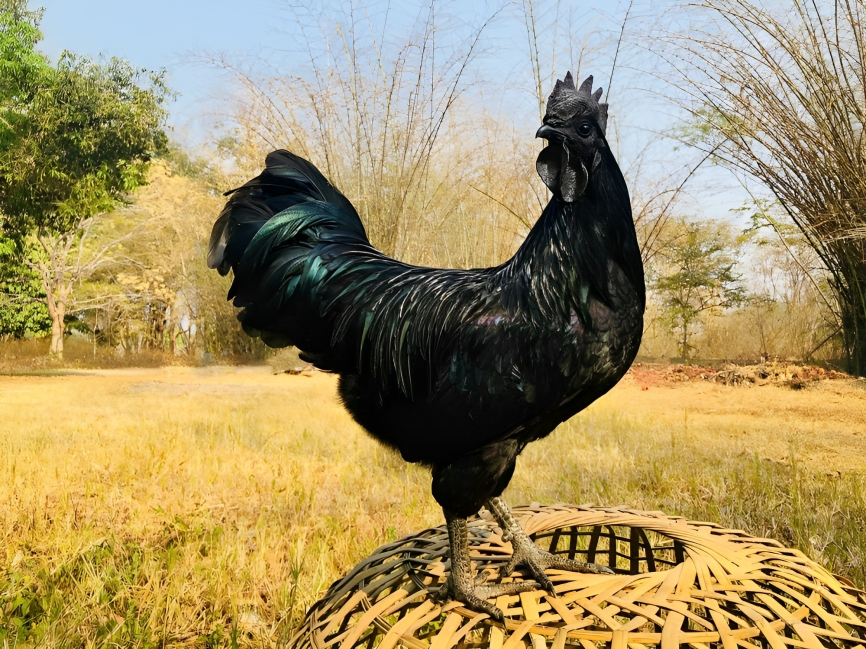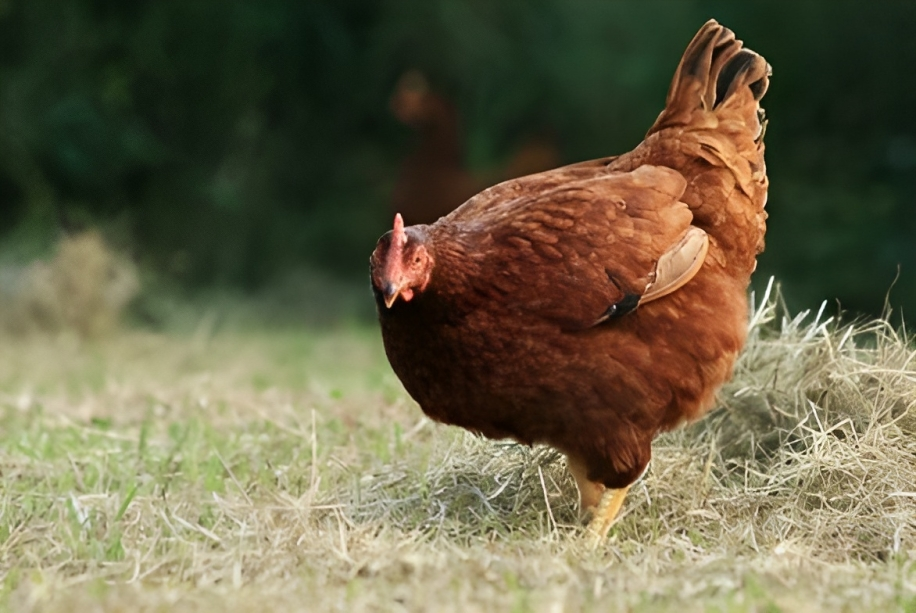India is home to various indigenous chicken breeds, each adapted to different climates and serving various purposes, from egg-laying to meat production. Some notable Indian chicken breeds include:Poultry farming in India is a significant part of the agricultural landscape and plays a vital role in the country’s economy. Here are some key points about poultry farming in India:Poultry farming in India ranges from small backyard operations to large commercial farms. Small-scale farming often involves indigenous breeds and is prevalent in rural areas, while commercial farms utilize advanced technology and high-yielding breeds.

Aseel:
Known for their strength and fighting abilities, Aseel chickens have a muscular build. They’re primarily used for cockfighting but are also raised for their meat.Originally bred for fighting, Aseel chickens are prized for their combat abilities, including their endurance and strength. Despite their association with cockfighting, efforts are made by some breeders to maintain and promote the breed for its genetic purity and potential in other areas such as meat production. Their meat is considered flavorful and of good quality. Here are some additional insights into Aseel chickens and their characteristics:
-
Appearance: Aseel chickens are known for their muscular and robust build. They often have a distinctive upright posture, powerful legs, and well-developed chest muscles, reflecting their strength and agility.
-
Temperament: Traditionally bred for their fighting prowess, Aseel chickens can exhibit a spirited and assertive temperament. However, their behavior can vary widely based on individual upbringing and environment.
-
Adaptability: They are known for their hardiness and adaptability to various climates. This adaptability has led to their popularity in different regions where they’ve been introduced.
-
Egg-laying Ability: While they are not primarily bred for egg production, Aseel hens can lay a moderate number of eggs compared to some other breeds, contributing to their utility beyond their fighting abilities.
-
Conservation Efforts: Some conservationists and breed enthusiasts are actively working to preserve the Aseel breed, recognizing its historical significance and genetic uniqueness. These efforts focus on maintaining the breed’s purity and promoting its qualities for different purposes, such as meat production and its ability to thrive in diverse environments.
The Aseel chicken’s multifaceted nature, with qualities extending beyond its fighting abilities, is gaining attention among breeders and conservationists who seek to highlight its diverse attributes and potentials for various agricultural aspects

Kadaknath
Kadaknath chickens are known for their striking appearance, featuring entirely black plumage, including their feathers, skin, bones, and even internal organs. This distinctive black coloration sets them apart from other chicken breeds. The Kadaknath chicken’s distinct black appearance and purported health benefits have contributed to its popularity and demand, not only in local markets but also among those interested in niche and specialty poultry products. here are some more interesting facets about Kadaknath chickens:
-
Adaptability: Kadaknath chickens are well-adapted to free-range environments, thriving in the rugged terrains and climatic conditions of Madhya Pradesh. They have a reputation for being hardy and resilient, suited to diverse environmental challenges.
-
Nutritional Attributes: Beyond their unique appearance, the black meat of Kadaknath chickens is renowned for its nutritional value. It’s believed to have lower fat content, higher protein levels, and certain medicinal properties, which has contributed to its popularity among health-conscious consumers.
-
Cultural Significance: Kadaknath chickens hold cultural significance in local traditions and cuisines. They are often part of traditional recipes and culinary practices, symbolizing a distinct regional heritage and culinary identity.
-
Conservation Efforts: Due to their unique characteristics and genetic value, there are concerted efforts to conserve and promote the Kadaknath breed. Conservation programs focus on preserving its genetic purity and promoting sustainable breeding practices to maintain its distinct traits.
-
Economic Impact: The popularity of Kadaknath chickens has led to economic opportunities for local farmers and breeders. It has become a source of income for many, contributing to livelihoods and rural economies.
The Kadaknath chicken’s remarkable qualities, both in terms of its unique appearance and perceived health benefits, have made it a fascinating breed in the realm of poultry farming, cultural practices, and culinary exploration.

Vanaraja chickens
Vanaraja chickens are known for their fast growth rate, reaching marketable size relatively quickly compared to some other breeds. These chickens are well-suited to diverse environmental conditions and management systems prevalent in rural areas. They can thrive under semi-intensive or free-range systems commonly found in small-scale farming setups.The development of Vanaraja chickens aimed to provide rural poultry farmers with a breed that offers a balance between meat production, egg-laying ability, and adaptability to local conditions, thereby supporting livelihoods and enhancing productivity within rural communities. here are some additional insights into Vanaraja chickens:
Efficient Feed Conversion: Vanaraja chickens are known for their efficient feed conversion, meaning they can convert feed into body weight relatively well compared to some other breeds. This characteristic contributes to their cost-effectiveness in poultry farming.
Adaptability and Resilience: Their ability to adapt to various climatic conditions and management systems, coupled with their resilience, makes them suitable for a wide range of environments, especially in rural settings where resources might be limited.
Egg-laying Capabilities: While primarily recognized for their fast growth and meat production, Vanaraja hens also exhibit decent egg-laying abilities. This dual-purpose aspect adds to their value for small-scale farming where both meat and egg production are essential.
Role in Livelihood Improvement: The introduction and promotion of Vanaraja chickens have positively impacted the livelihoods of many rural poultry farmers. Their high productivity, adaptability, and economic viability contribute to sustainable income generation in these communities.
Support for Sustainable Farming: These chickens are part of efforts to promote sustainable farming practices in rural areas, emphasizing local breeds that can thrive under varying conditions without excessive dependence on external resources.
The development and promotion of Vanaraja chickens represent a concerted effort to enhance agricultural productivity, support rural economies, and provide sustainable solutions for poultry farming within diverse and resource-constrained environments.

Gramapriya
Gramapriya was developed to meet the requirements of rural poultry farmers who sought a breed that could efficiently lay eggs while also offering decent meat quality. It was designed to be well-suited for small-scale farming setups. Gramapriya chickens are known for their high egg-laying capacity. They typically lay a significant number of eggs over the course of a laying cycle, making them suitable for egg production purposes in rural settings. Like many locally developed chicken breeds in India, Gramapriya is bred to adapt well to various climatic conditions and management systems prevalent in rural areas. They are suitable for free-range or semi-intensive farming systems. Like many locally developed chicken breeds in India, Gramapriya is bred to adapt well to various climatic conditions and management systems prevalent in rural areas. They are suitable for free-range or semi-intensive farming systems. here are further details about Gramapriya chickens:

Transylvanian ,Naked Neck
Naked Neck chickens are highly adaptable to hot climates. The lack of feathers on their necks allows for better heat dissipation, making them more tolerant of warm temperatures compared to fully feathered breeds. This adaptability to hot weather makes them suitable for regions with high temperatures or tropical climates. Naked Neck chickens are known to be decent layers of eggs and also provide good-quality meat. Their dual-purpose nature makes them valuable for households and small-scale farming operations. here are further details about Naked Neck chickens:
Feather Arrangement: The absence of feathers on their necks, giving them a “naked” appearance, isn’t limited to just the neck region; they might also have fewer feathers on their bodies compared to fully feathered breeds. This unique feather arrangement contributes to their heat tolerance.
Adaptability and Hardiness: Beyond their tolerance to heat, Naked Neck chickens are known for their overall hardiness and adaptability to various environmental conditions. They can withstand temperature fluctuations and adjust well to different management systems.
Egg-laying Abilities: While not the highest egg-laying breed, Naked Neck chickens are decent layers, providing a consistent supply of eggs. This quality makes them suitable for small-scale farming setups or backyard poultry keeping, offering a regular source of fresh eggs.
Meat Quality: In addition to egg production, they are valued for their good-quality meat. Their dual-purpose nature allows them to serve both as egg layers and as a source of meat, making them practical for households seeking self-sufficiency in poultry products.
Sustainability in Farming: Naked Neck chickens’ ability to thrive in hot climates, coupled with their dual-purpose attributes, contributes to sustainable farming practices. They efficiently utilize resources and provide both eggs and meat, supporting self-sufficiency in small-scale farming setups.
Their adaptability, hardiness, and dual-purpose nature position Naked Neck chickens as valuable assets in regions with warm climates, contributing to sustainable poultry farming and household nutrition.
The diversity of chicken breeds in India reflects the country’s rich agricultural landscape and the varying needs of farmers across different regions. Each breed has been selectively bred or adapted to thrive in specific environments and serve various purposes, whether for meat, egg production, adaptation to climates, or cultural significance. This diversity allows farmers to choose breeds that best suit their local conditions and meet their specific requirements, contributing to the sustainability and productivity of poultry farming across India. Additionally, these breeds often hold cultural significance,
